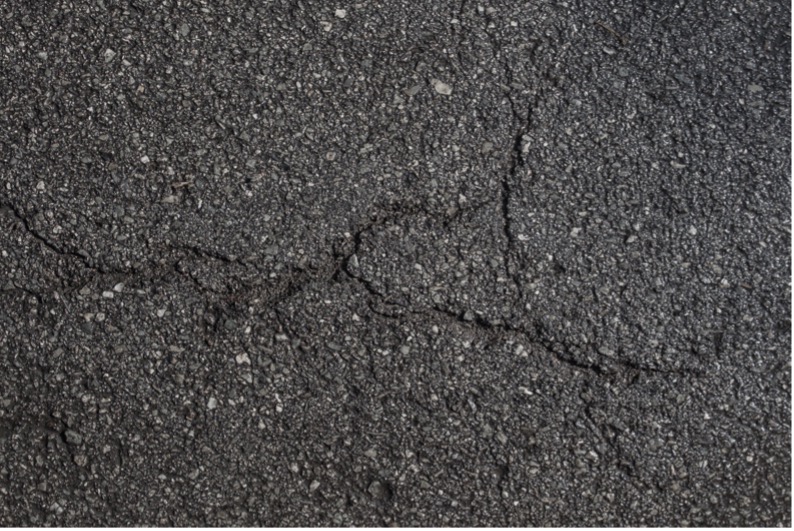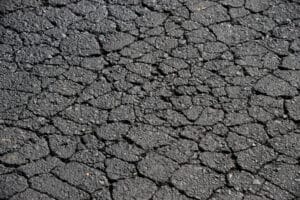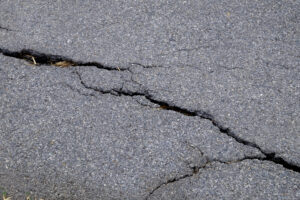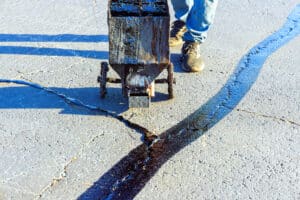Is your new asphalt condition low-quality, and are worried about signs of a bad asphalt job? Poorly executed asphalt applications can lead to costly repairs for property owners. It’s crucial to be able to spot low-quality asphalt services to ensure you receive the quality paving you deserve.
Below, we’ll break down five signs of a bad asphalt job to watch, their causes, and how to fix them with high-quality asphalt professionals.
6 Signs of a Bad Asphalt Job to Watch
Recognizing the signs of a bad asphalt job is crucial – not only to avoid costly repairs and premature deterioration, but also to ensure the safety and functionality of your paved surfaces. As a property owner, investing in high-quality asphalt paving is essential for pedestrian safety and compliance with local codes. By being aware of the signs of a bad asphalt job, you can make informed decisions and select reputable contractors, making sure your property’s pavement has the longevity and integrity it needs.
1. Raveling
One of the first signs of a bad asphalt job asphalt raveling. If the asphalt isn’t installed in a timely manner, the aggregate will start to ravel. A poorly mixed aggregate and bad compaction can also be a cause of raveling. Raveling can cause the asphalt to become more rough, less skid resistant, and can result in faster deterioration.
Once raveling has occurred, there are some actions you can take to repair the asphalt instead of getting a completely new asphalt job. The best way is to get asphalt seal coating done on the affected area to cover it.
2. Cracking
Another clear sign of a poor asphalt job is cracking. Asphalt cracking can happen for several reasons, including improper installation, excess moisture infiltration, natural aging, and extreme temperature changes like freezing and thawing cycles. Cracks not only affect the look of the pavement but also signal underlying structural problems that can lead to bigger issues if left unaddressed.
There are two main types of asphalt cracking you’ll often see:
- Fatigue Cracking (also called Alligator Cracking): This type of cracking looks like the scales of an alligator’s skin and is typically caused by poor installation practices, inadequate base support, or the gradual breakdown of underlying asphalt layers. When the pavement can’t handle the repeated stress of traffic loads, it flexes and cracks in a web-like pattern.
- Thermal Cracking: Thermal cracks appear as long, narrow lines that usually run perpendicular to the direction of the pavement. They form when asphalt isn’t flexible enough to expand and contract with changing temperatures. Even high-quality asphalt can experience thermal cracking over time, but poor material quality or improper mix design can make it worse.
Three methods fix alligator and thermal cracking: crack sealing, sealcoating, and repairs. There are many causes of cracks with varying damage severity, so understanding when to seal vs. repair cracked asphalt is crucial to knowing how to fix them.
Crack sealing is ideal for filling cracks ¼ inch to 1 inch wide. Larger asphalt cracks, like alligator cracking, require special sealants since they’re too large to use standard rubberized crack sealant – yet too small for repairs. For extensive asphalt cracks requiring repairs, use replacement patching with a subbase below the pavement to strengthen the foundation.
With these insights, you’ll know how to work with pavement contractors to fix cracks potentially caused by installation or maintenance issues.
3. Uneven Surface
As with any outdoor surface, wear and tear and deterioration are inevitable. However, with newly paved or maintained asphalt, you shouldn’t be experiencing uneven surfacing soon after servicing.
Some signs of a bad asphalt job with uneven surfacing are:
- Improperly laid slabs during initial pavement or maintenance
- Inaccurate land surveys before construction
- Inadequate asphalt thickness based on traffic volume
- Poor preparation, asphalt mixing, and compacting
- Low-grade joint construction
There are other causes of uneven asphalt surfaces, such as environmental factors and aging over time. Sealcoating or asphalt repairs may be warranted depending on the uneven surface severity.
4. Shrinkage
Low-quality asphalt workmanship and materials can lead to premature shrinkage. Typically, during the installation process, improper compaction creates air pockets within the asphalt mixture. Water can seep into these gaps, expand, and contract them during freeze-thaw cycles – causing shrinkage.
Asphalt resurfacing with proper compaction helps remove air pockets caused by shrinkage. In addition to asphalt maintenance, like crack sealing and sealcoating, it can provide an extra layer of protection to prevent water intrusion and pavement deterioration.
5. Slow Water Drainage
Slow water drainage or standing water on asphalt is one of the top signs you need asphalt repairs. Drainage issues can be caused by poor installation or improperly sloped pavement. It can lead to more significant structural issues, like cracks, potholes, and public safety hazards.
Standing water can be prevented by asking your asphalt professional about the following solutions:
- Strong drainage system installation
- Proper sloping
- Sealcoating to prevent moisture penetration
- Replacement patches
- Pothole repairs
- Crack sealing
If you notice slow water drainage or standing water after a recent asphalt service, it’s one of the top signs of a bad asphalt job.
6. Rough Seams
Last on our list of signs of a bad asphalt job is rough seams. During initial pavement, seams are required to connect your asphalt to the surface. Like fabric, it’s “sewn” together, so it doesn’t unravel or separate after it’s compacted.
If your asphalt contractors took too long to pave the seams, it may not connect. The good news is that rough seams can be repaired with sealcoating services. Its thin liquid layer helps seal in any open or rough seams to ensure it sticks together for a smoother-looking surface and enhanced curb appeal.
Hire High-Quality Asphalt Repair Professionals at Superior Asphalt
Understanding the signs of a bad asphalt job is crucial for homeowners and commercial property owners with parking lots. In addition to repairs, low-quality asphalt services pose serious safety hazards, such as tripping or vehicle damage.
Now that you know low-quality paving signs, get your asphalt repaired with high-quality asphalt professionals at Superior Asphalt. Our company has been in the asphalt industry since 1987 and takes pride in satisfying our customers with professionalism.
Contact us for questions or asphalt repairs today!
Frequently Asked Questions
How can I tell if my asphalt was poorly installed?
Several warning signs can indicate a bad asphalt job, including cracking, uneven surfaces, rough seams, slow water drainage, and premature shrinkage. If you notice raveling or potholes forming soon after installation, it could be due to improper compaction, poor-quality materials, or rushed workmanship. Identifying these issues early can help you avoid costly repairs.
Can a bad asphalt job be repaired, or do I need a complete repaving?
The extent of the damage will determine the best solution. Minor issues like small cracks, rough seams, and uneven surfaces can often be fixed with sealcoating, crack sealing, or resurfacing. However, if the asphalt has widespread deterioration due to poor installation, a full-depth repair or repaving may be necessary to ensure long-term durability.
What should I look for when hiring an asphalt contractor to avoid poor workmanship?
To prevent a bad asphalt job, choose a reputable contractor with experience, proper licensing, and positive customer reviews. Ask about their paving process, materials used, and warranty options. A professional asphalt company should also assess your property’s drainage needs and traffic load to ensure the pavement is installed correctly.




